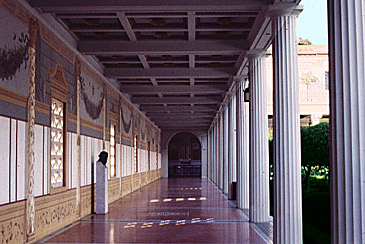
You walk into the shade of the roofed colonnade, called by some the "Golden Porticus." The columns, like still sentinels fashioned from tawny marble, speckled with red, hold their stations all around you. Between each set of columns stands a maiden, fifty in all, once you've made your count. And before each of them is a young man upon his steed. This motionless crowd also includes one prominent old man, sword drawn, aspect fierce. This is Danaus and these his daughters, the Danaids, with the ill-fated first husbands whom they killed on their wedding night. (NB: This is a modern reconstruction of the porticus at the Villa dei Papyri, Herculaneum.)
On the walls behind the statues you view a series of painted terracotta relief panels with elaborate decorations in an archaizing style. One panel depicts the head of Medusa (with a strange smile on her lips) between Perseus and Athena, another shows Apollo and Hercules struggling for the Delphic tripod. Between the larger reliefs you notice representations of Isis holding a sistrum and flanked by sphinxes. This Egyptian symbolism calls to mind the battle of Actium, and you remember that Marc Antony associated himself with Hercules as strongly as Augustus linked himself with Apollo. These panels seem to be conveying a message about the defeat of dangerous foreign females and hubristic heroes!
Scrawled in charcoal at the base of the statue of Danaus you see Romanes, domum remanent! -- bad Latin, dangerous politics. You are puzzled by the prominence given to the blood-curdling tale of the Danaids. What does it have to do with Pax Romana or reverence toward Apollo? At the back of your mind you are troubled by some verses from Vergil's Aeneid concerning Pallas, the son of Evander, who lived on the Palatine before Rome existed. You remember Vergil's description of the sword belt worn by Pallas, which depicts the story of the Danaids:
impressumque nefasuna sub nocte iugali caesa manus iuvenum foede thalamique cruenti. (10.497-98)
"The embossed tale of wickedness -- the band of young men foully slain on a single wedding night and the bloody marriage beds."
At the end of the epic, Turnus is wearing this sword belt, which he boastfully took from the body of Pallas after he had killed that young man; when Aeneas sees this saevi monimenta doloris ("memorial of savage grief," 12. 945), he is consumed with rage and buries his sword in the chest of Turnus, who is kneeling in supplication before him. You wonder whether Vergil had this monument, the temple complex of Palatine Apollo, in his mind when he chose to portray the Danaids on the sword belt that plays such an ambiguous role at the end of the epic. If so, is it possible that the poet's warning to Turnus was also obliquely meant for Augustus?
nescia mens hominum fati sortisque futurae et servare modum rebus sublata secundis! (10.501-502)
"O mind of men ignorant of fate and of the destiny to come, O mind that does not know how to preserve moderation when elated by favorable circumstances!"
![]() To follow Tristia Tresunus to his eighth stop, take the Bibliotheca Colonnade exit; to retrace your steps toward his ninth stop, take the
Temple of Palatine Apollo exit.
To follow Tristia Tresunus to his eighth stop, take the Bibliotheca Colonnade exit; to retrace your steps toward his ninth stop, take the
Temple of Palatine Apollo exit.